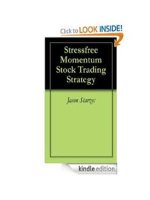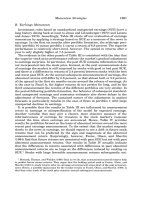essential stock picking strategies - what works on wall street - daniel a. strachman
Bạn đang xem bản rút gọn của tài liệu. Xem và tải ngay bản đầy đủ của tài liệu tại đây (911.14 KB, 240 trang )
ESSENTIAL STOCK
PICKING STRATEGIES
@Team-FLY
ESSENTIAL STOCK
PICKING STRATEGIES
What Works on Wall Street
Daniel A. Strachman
John Wiley & Sons, Inc.
Copyright © 2002 by Daniel A. Strachman. All rights reserved.
Published by John Wiley & Sons, Inc.
Published simultaneously in Canada.
No part of this publication may be reproduced, stored in a retrieval system, or
transmitted in any form or by any means, electronic, mechanical, photocopying,
recording, scanning, or otherwise, except as permitted under Sections 107 or 108
of the 1976 United States Copyright Act, without either the prior written
permission of the Publisher, or authorization through payment of the appropriate
per-copy fee to the Copyright Clearance Center, 222 Rosewood Drive, Danvers,
MA 01923, (978) 750-8400, fax (978) 750-4744. Requests to the Publisher for
permission should be addressed to the Permissions Department, John Wiley &
Sons, Inc., 605 Third Avenue, New York, NY 10158-0012,
(212) 850-6011, fax (212) 850-6008, E-Mail:
This publication is designed to provide accurate and authoritative information in
regard to the subject matter covered. It is sold with the understanding that the
publisher is not engaged in rendering professional services. If professional advice
or other expert assistance is required, the services of a competent professional
person should be sought.
Wiley also publishes its books in a variety of electronic formats. Some content that
appears in print may not be available in electronic books. For more information
about Wiley products visit our Web site at www.wiley.com
Designations used by companies to distinguish their products are often claimed as
trademarks. In all instances where the author or publisher is aware of a claim, the
product names appear in Initial Capital letters. Readers, however, should contact
the appropriate companies for more complete information regarding trademarks
and registration.
ISBN: 0-471-40063-7
Printed in the United States of America
10987654321
To my parents
@Team-FLY
The day is short; the task is great.
—Ethics of the Fathers
Chapter II, Verse 20
There’s a way to do it better. Find it!
—Thomas A. Edison
CONTENTS
• ix •
Acknowledgments xi
Introduction xiii
chapter one
Investing 101 1
chapter two
Growth and Value Managers 25
chapter three
Sector Fund Managers 117
chapter four
Resources 171
chapter five
Conclusion 189
Glossary 203
Notes 209
Index 211
ACKNOWLEDGMENTS
• xi •
There are many steps and processes that one completes in
order to get a book from just an idea to the point where it is
bound and sitting on the shelf in a bookstore. All along the
way there are many people who contribute to making the
concept become a reality. However, a few individuals have
contributed greatly to making this particular project hap-
pen, and I would like to thank them for their guidance and
support during the past year that I have been working on
this project. The individuals are in no particular order: Sam
Graff, the best newspaperman east of the Mississippi; Sarah
Theodore, a fantastic librarian and researcher unlike any
other; Desmond MacRae, a truly one-of-a-kind individual
with theories on practically everything; and Jeff Zack, a
dear friend who always provides me with great advice and
guidance on my projects. I need to thank all of the money
managers who agreed to be profiled in these pages—because
without them there would be no book. Special thanks also
to Annette, Stanley, David, Ruth, Amy, and Felice for their
guidance and support.
@Team-FLY
Of course no book would get published without a publisher,
so to all of the people at John Wiley & Sons, especially Pamela
van Giessen and Joan O’Neil, thanks for everything. I hope
this book is everything you intended it to be when you gave
me the go-ahead to write it.
DANIEL A. STRACHMAN
New York City
April 2002
ACKNOWLEDGMENTS
• xii •
INTRODUCTION
• xiii •
Over the past six or seven years everything was the stock
market and the stock market was everything. Cabdrivers,
teachers, waiters, and window washers—everybody was talk-
ing about this stock or that stock and how every single one
was going up.
No longer did you need to know anything about fundamen-
tal or technical analysis or anything about a company’s bal-
ance sheet or income statement to make money in the market.
All you had to do was place an order, hold it for a day or two,
and bam! You were a Wall Street whiz!
The stories were all over television, radio, and print, not to
mention the Internet. They told of people who made millions
when their companies went public or by putting a pittance
into a start-up tech company. Some individuals even saw the
value of their retirement accounts triple overnight.
Everyone had the bug and the bug had everyone. Even peo-
ple in other professions got into the act. Investing novices
who never before had a penny in the stock market began to
expect that they would make 30 to 40 percent a year on their
mutual fund investments. And many mutual fund managers
and salespeople told them that they were right. It was as if the
investing public was under a spell, believing that the market
could not go down. The haze of greed blinded everyone.
“I got used to buying a stock at 10 in the morning and mak-
ing 10 or 15 percent by 2 in the afternoon and selling it before
the close,” said a graphic designer who lives in Manhattan.
“Sometimes it took a day or two, but I would almost always
make 20 to 30 percent on every stock I purchased. Trading
stocks become a better business than my actual business.”
The tech craze seemed to blossom overnight as stocks went
from 9 to 90 in a matter of minutes. The demand clearly out-
weighed the supply. For a while it seemed as if it was never go-
ing to end.
Yet as quickly as people started making money, they began
to lose it. By the spring of 2000 times had changed—changed
for the worse. First the small technology companies began to
run out of money (they never made any to begin with) as they
burned through the cash they raised by going public. Then the
large technology companies started to have problems. Slowly
the nontechnology companies fell ill as well, and before you
knew it the markets took to their sickbeds and did not seem as
if they were ever going to get up.
The problem had too many causes to write about in this
book. The stock market from the mid-1990s to early 2000
will be fertile territory for books and business school lectures
for years to come. And while many people delight in schaden-
freude, I don’t, and therefore I have chosen to leave out the
horror stories about people losing millions in a month and to
move on to the good stuff.
One of the main problems was that for retail investors, trad-
ing stocks stopped being fun and turned into something that
resembled work.
INTRODUCTION
• xiv •
It stopped being fun because people had to dig to find
good investments. Many people—or at least many of those
who had experienced such huge growth in their portfolios—
had little or no experience picking stocks or making sound
investment decisions. These people had grown accustomed to
buying anything with a tech or dot-com slant to it without
understanding the first thing about the company. Now they
came to realize that to invest wisely, you need to understand
a company. That takes study, and many people didn’t want
to put in the time.
The problem wasn’t just with the retail investor but also
with many of the so-called investment professionals. The tech
bug bit them, too, giving them a sort of tech tetanus that left
them unable to move out of the sector in time.
Like the rest of the investing public, many of these men and
women have also had a hard time picking winners, because
the game has changed and they no longer understand the
rules. Instead many are sitting in a daze, lost in a new fog.
So what really happened, and how did things get so out of
control? Well, I don’t really have an answer, nor does anyone
else. One thing I do know: If you look at the history of the
markets, you will find that markets like the ones of the mid-
and late 1990s happen again and again. The difference be-
tween the 1990s and other bubbles, though, is the fantastic
growth of news and information about the stock market.
Many things killed the bull market, but not the least of them
was the Internet.
Twenty years ago, it was next to impossible to get market
prices in your home or office. Now not only can you get live
prices, but you can get indications of who is willing to buy or
sell a stock, learn the volume of shares traded, and, in some
cases, see who is buying what and why.
INTRODUCTION
• xv •
“It used to be that the only people who had market infor-
mation or intelligence were people in the market,” said one
longtime broker. “Nowadays, everybody not only thinks that
they are in the market, but they believe that they have as much
information about the market as the professionals have. In
some cases they do, but in most cases they don’t, and that is
why people are getting hurt. Everyone thinks it is a level play-
ing field, but in reality it is not.”
When the market did turn into a bear, the media enjoyed re-
porting that one of the reasons was because very few money
managers and day traders had previously experienced a down
market. I think they should have reported that those investors
and some money managers and day traders had forgotten the
past, creating a problem that has stifled the growth of the mar-
ket. People tend to forget how good they had it and how long
it took them to recover from the bad times.
Many people believe that they can predict which way mar-
kets and individual stocks will move. Some have been very suc-
cessful at it, while others have been pretty poor at it. One thing
that seems to be certain is that the key to successful investing is
being able to withstand both the good times and the bad.
Like the gambler who keeps just enough chips in her pocket
to play another day and the soldier who retreats so he can
fight again, the key to successful investing is time and the abil-
ity to withstand hardship. You have to live to invest another
day, and while this may sound easy, it isn’t, because we are
dealing solely with money!
Money—it’s been called “a pain in the ass,” “the root of all
evil,” and “the one thing that makes the world go round.”
Whatever it is, people like it, and they like it even more when it
comes to them with ease. They like to spend it, they like to
flash it, and some may even like to roll around naked in it.
INTRODUCTION
• xvi •
@Team-FLY
Many people believe that regardless of who you are, what you
do, or how much you have, you can never have enough money.
Back in 1995, I was a trainee working at a large New York
institutional brokerage. As part of my training, I rotated
through every area of the firm’s brokerage units. The trading
desks in most firms look the same, so unless someone tells you
what a particular desk is trading, it is very hard to distinguish
one group from another.
On this particular day, I was in the municipal bond area, an
area that was on the verge of extinction, partly because the
stock market was on a tear. We were all talking about this new
stock issue, Netscape—how it was about to go public and was
going to go through the roof, and how we all wanted to short
the stock because it seemed unfathomable that the stock of a
company that basically did nothing more than make getting to
the Internet easier was worth anywhere near the amount it
was trading for. Besides, at the time very few people used the
Internet for anything more than e-mail.
Little did we know that it was the start of something big!
From that point on, every Internet stock, as well as almost
every other initial public offering, seemed to double in price, if
not triple, right out of the gate. It was quite a ride. It was a ride
that many investors will remember for a very long time. Many
will long for the days of the Internet craze—forgetting the heavy
losses—and wish for the days of doubles and triples in a matter
of hours. They’ll look backward nostalgically, of course, only
until the market turns and stocks start going up again.
Still, maybe the opportunity exists right now and investors
don’t see it. Maybe there are people out there who don’t need
skyrocketing markets or the latest craze to post strong returns.
Maybe there are people who have done well and continue to
do well regardless of market conditions. This leads me to the
INTRODUCTION
• xvii •
idea behind Essential Stock Picking Strategies: What Works
on Wall Street.
The purpose of this book is to provide you with unique in-
sight into money managers. It is for readers who want to learn
about the different investment styles and strategies of money
managers who have made sound investment decisions over a
significant period of time. It is not to make these men and
women out to be the best or necessarily the brightest; it is
merely to show that consistency is the most important thing
when it comes to investing. The idea is to illustrate that having
strict investment principles and following a strict investment
strategy is more important then finding the next best thing. I
wrote this book to give you a better understanding of what
works on Wall Street, so that you can profit from good invest-
ment strategies and make money in both bull and bear markets.
I have chosen money managers who have solid track
records and who have been in the money management busi-
ness for some time. Most of them are names that you will not
recognize, and there is a reason for that—a reason you will
understand when you finish this book.
A great Wall Streeter once said, “Never confuse brains with a
bull market.” I believe the people profiled in these chapters have
the brains to be successful in both bull and bear markets and
that these pages offer you the chance to profit from their brains.
INTRODUCTION
• xviii •
ESSENTIAL STOCK
PICKING STRATEGIES
★ chapter one ★
INVESTING 101
• 1 •
Stocks and the Equity Markets
To understand the money management business, one first has
to understand the stock market and how it works.
First one needs to realize that when people say “the stock
market” they mean all of the equity markets around the
world. And while many of us believe that New York is the
center of the universe for everything, many others believe
that those of us who think this way are egotistical snobs.
When it comes to trading stocks, though, New York is truly
the place. Sure, there are other markets around the globe in
all the major cities of the world, and there are markets
throughout the United States; but everything everywhere
having to do with the equity markets gets its cue from the
seven square miles that is New York City and the mythical
place we all call Wall Street.
In order to understand the stock market and how it works it
is important to have a clear understanding of what a stock or
equity is (stocks and equities are the exact same thing, and the
terms can be used interchangeably). According to the Dictio-
@Team-FLY
nary of Business Terms, there are two types of stock: common
and preferred.
Common stock security representing an ownership in-
terest in a corporation. Ownership may also be shared
with preferred stock, which has prior claim on any divi-
dends to be paid and, in the event of liquidation, to the
distribution of the corporation’s assets. As owners of the
corporation, common stockholders assume the primary
risk if business is poor, realize the greater return in the
event of success, and elect the board of directors that con-
trols the company.
1
Preferred stock part of the capital stock of a corpora-
tion that enjoys priority over the remaining stock, or
common stock, in the distribution of dividends and in the
event of dissolution of the corporation, also in the distrib-
ution of assets.
2
Now let’s explore the markets and how they work.
Brokers have been trading stocks in the United States since the
1700s. However, organized buying and selling of stocks started
at the foot of Manhattan near Wall Street and are shrouded in
scandal. According to Charles Geisst, a leading Wall Street histo-
rian, there were few if any formal rules or regulations governing
the trading of stocks until speculator William Duer caused a fi-
nancial meltdown. Duer, a British expatriate, was a land specu-
lator who borrowed large amounts of money from banks. He
overextended himself and could not pay off his debts, causing
some banks to fail and others to become very nervous that a
landslide effect would hurt their balance sheets and in turn cause
the nation’s financial system to completely collapse.
ESSENTIAL STOCK PICKING STRATEGIES
• 2 •
The failures and potential failures of the banks were the
stimulus for 24 brokers to meet under a buttonwood tree in
1792 and sign the famed Buttonwood Agreement, which for-
malized trading. This formalization provided an outlet or
arena for institutions, both financial and nonfinancial, to issue
stock and in turn raise capital to not only expand their busi-
nesses but also make the businesses stronger and avoid the risk
of collapse due to one individual’s recklessness.
Duer had a different fate. He was sent to debtors’ prison,
where he died penniless.
3
Today one can still see the spot where the agreement was
signed. Although the buttonwood tree is long gone, the loca-
tion is part of the office complex at 60 Wall Street that is home
to a number of Wall Street’s most powerful firms, including JP
Morgan Chase.
Trading continued for a time outside by the tree. In 1793 a
group of traders decided to move indoors, a move that in
1817 evolved into the New York Stock and Exchange Board.
Another group of traders continued to trade outside by the
curb; however, this group eventually went inside as well, form-
ing what is now the American Stock Exchange (AMEX).
In 1863 the New York Stock and Exchange Board changed
its name to its current nom de plume: the New York Stock Ex-
change. The NYSE established formalized hours for trading in
1873: 10 A.M. to 3 P.M. weekdays and 10 A.M. to noon on Sat-
urday (prior to that the hours had been flexible). Since 1873,
the New York Stock Exchange has changed its hours of opera-
tion just three times—in 1887, 1974, and 1985. The change in
1985 moved the trading day from the hours of 10 A.M. to 4
P.M. to its current hours, 9:30 A.M. to 4 P.M.
The curb traders moved inside in 1921 as the New York
Curb Market Association (later the New York Curb Exchange).
INVESTING 101
• 3 •
In 1953 the Curb Exchange changed its name to the American
Stock Exchange and in 1998 the American Stock Exchange
merged with the Nasdaq Stock Market. The New York Stock
Exchange continues to remain an independent entity owned by
its seat holders.
The Nasdaq Stock Market was born in 1971 as a result of
the Securities and Exchange Commission’s decision that the
over-the-counter securities industry needed to be automated.
The SEC asked the National Association of Securities Dealers,
Inc. to develop a market for these securities. This action cre-
ated the first electronic stock market.
These three—the New York Stock Exchange, the Ameri-
can Stock Exchange, and the Nasdaq Stock Market—are the
primary markets where stocks are traded. While regional
and other electronic markets operate and have for some
time, for the most part stock trades are executed on the
NYSE, the AMEX, or the Nasdaq. There are many places to
learn about the evolution of the stock markets and how they
work, and, as with most subjects these days, the best place
to start is the Internet.
The NYSE and AMEX differ from the Nasdaq in one sig-
nificant respect. The New York and American exchanges
are both called a “specialist market,” and the Nasdaq is a
“dealer market.”
The difference is in the way orders are taken and executed.
A specialist market—also known as an agency auction market
system—is designed to allow the public to meet the public as
much as possible, meaning people trade with each other and
do not work with dealers. Simply put, it is a place where buy-
ers and sellers meet face-to-face to trade their stocks. The ma-
jority of volume in these markets occurs with no intervention
from dealers or specialists.
ESSENTIAL STOCK PICKING STRATEGIES
• 4 •
The specialists make markets in stocks and work on the
floors of the NYSE and the AMEX. The responsibility of spe-
cialists is to make fair and orderly markets in the stocks that
are assigned to them. They must always yield to public orders,
which means that they may not trade for their own accounts
when there are public bids and offers. While the lay public is
never allowed to actually enter to floor of the exchanges to
trade, the “public” in this case is the brokers who act on be-
half of firms and the traders who act on behalf of themselves.
The specialists’ job is to eliminate imbalances of supply and
demand when they occur and maintain a narrow spread in
the market for each stock. The specialists are governed by the
exchange, which has in place strict guidelines for trading and
continuity that must be observed. Regardless of market con-
ditions, specialists are required to make a continuous market
in their stocks. After the crash of 1987, many of the smaller
specialist firms were forced to merge with larger firms or went
out of business because of that rule. As long as someone was
willing to sell stock, they had to buy it regardless of price and
even if no one else wanted it. This caused a drain on their
capital and in turn forced them to either take the action of
merging with some firm that had a stronger balance sheet or
go out of business.
The Nasdaq is also commonly, and somewhat confusingly,
called the OTC or over-the-counter market. The Nasdaq mar-
ket is an interdealer market represented by over 420 registered
securities dealers trading more than 4,750 different issues.
4
These dealers are called market makers.
Unlike on the NYSE or AMEX, the Nasdaq market does
not operate as an auction market. Instead, market makers are
expected to compete against each other to post the best quotes
(best bid/ask prices) on the system for all buyers and sellers to
INVESTING 101
• 5 •









